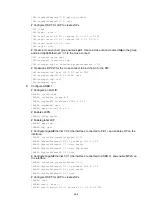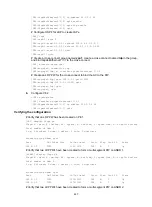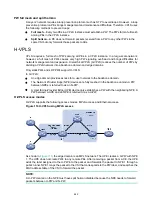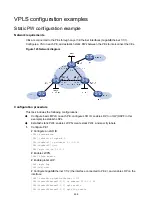
443
Figure 120 H-VPLS using Ethernet access
As shown in
, the edge domain is an Ethernet network. The UPE and NPE 1 establish a
point-to-point Ethernet QinQ connection in between. After the UPE receives a packet from a CE, it
adds an outer VLAN tag into the packet and forwards the packet to NPE 1. NPE 1 regards the outer
VLAN tag as the service provider VLAN tag. It maps the packet to the VSI that corresponds to the
VLAN tag and then searches the MAC address table of the VSI to forward the packet.
UPE dual homing and PW redundancy
To provide U-PW redundancy for a UPE, you can connect the UPE to two NPEs. Even if a U-PW fails,
all customer sites connected to the UPE maintain the connectivity.
In the H-VPLS using MPLS access as shown in
, the UPE is connected to two NPEs
through primary and backup U-PWs. The UPE uses the primary U-PW to forward traffic. When the
primary U-PW fails, the UPE uses the backup U-PW to forward traffic.
Figure 121 UPE dual homing and redundancy in H-VPLS using MPLS access
The backup U-PW is used in the following scenarios:
•
The primary U-PW goes down because the tunnel that carries the primary U-PW is deleted or a
fault detection mechanism such as BFD detects a tunnel failure.
•
The primary U-PW is deleted by the control plane. For example, the LDP session on the primary
U-PW link is down, causing the primary U-PW to be deleted.
•
BFD detects a failure of the primary U-PW.
















































